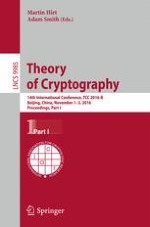2016 | OriginalPaper | Buchkapitel
Binary AMD Circuits from Secure Multiparty Computation
verfasst von : Daniel Genkin, Yuval Ishai, Mor Weiss
Erschienen in: Theory of Cryptography
Verlag: Springer Berlin Heidelberg
Aktivieren Sie unsere intelligente Suche, um passende Fachinhalte oder Patente zu finden.
Wählen Sie Textabschnitte aus um mit Künstlicher Intelligenz passenden Patente zu finden. powered by
Markieren Sie Textabschnitte, um KI-gestützt weitere passende Inhalte zu finden. powered by
